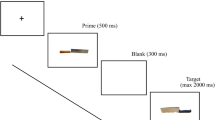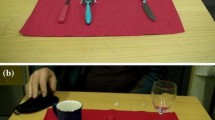Abstract
Behavioral and neuroscience studies have shown that observation of objects automatically evokes potential actions to interact with those objects. In this study, the left and right hand key presses were facilitated when they corresponded with the task-irrelevant handle orientation of household objects, which is termed the affordance effect. The present study investigated how the affordance effect is affected by the action context when other agents are observed acting on a neutral or dangerous object. Participants were shown a series of pictures in which an actor grasped a neutral or dangerous object and moved it away from or toward the participant. The participants were required to press different keys to identify a symbol which was presented above the last picture. The results showed that affordance effect of a neutral object was modulated by the direction of object movement. When the neutral object moved away from the participant, an affordance effect was observed if the perceived action was congruent with handle orientation, whereas the affordance effect emerged if the perceived action was incongruent with handle orientation when the object was moved toward the participant. However, for the dangerous object, the affordance effect was obtained regardless of object movement direction or congruency between perceived action and handle orientation. This result suggests that the processing of objects involves a sophisticated integration of body behavior with the object.


Similar content being viewed by others
References
Anelli, F., Nicoletti, R., Bolzani, R., & Borghi, A. M. (2013). Keep away from danger: Dangerous objects in dynamic and static situations. Frontiers in Human Neuroscience, 7, 344.
Aziz-Zadeh, L., Koski, L., Zaidel, E., Mazziotta, J., & Iacoboni, M. (2006). Lateralization of the human mirror neuron system. Journal of Neuroscience, 26, 2964–2970.
Bach, P., Bayliss, A. P., & Tipper, S. P. (2011). The predictive mirror: Interactions of mirror and affordance processes during action observation. Psychonomic Bulletin and Review, 18, 171–176.
Bekkering, H., Wohlschlager, A., & Gattis, M. (2000). Imitation of gestures in children is goal-directed. Quarterly Journal of Experimental Psychology, A, 53, 153–164.
Bertenthal, B. I., Longo, M. R., & Kosobud, A. (2006). Imitative response tendencies following observation of intransitive actions. Journal of Experimental Psychology Human Perception and Performance, 32, 210–225.
Brass, M., Bekkering, H., & Prinz, W. (2001). Movement observation affects movement execution in a simple response task. Acta Psychologica, 106, 3–22.
Bub, D. N., & Masson, M. E. J. (2006). Gestural knowledge evoked by objects as part of conceptual representations. Aphasiology, 20, 1112–1124.
Buccino, G., Vogt, S., Ritzl, A., Fink, G. R., Zilles, K., Freund, H. J., & Rizzolatti, G. (2004). Neural circuits underlying imitation learning of hand actions: An event-related fMRI study. Neuron, 42, 323–334.
Di Pellegrino, G., Fadiga, L., Fogassi, L., Gallese, V., & Rizzolatti, G. (1992). Understanding motor events: A neurophysiological study. Experimental Brain Research, 91, 176–180.
Edwards, M. G., Humphreys, G. W., & Castiello, U. (2003). Motor facilitation following action observation: A behavioral study in prehensile action. Brain and Cognition, 53, 495–502.
Ellis, R., Swabey, D., Bridgeman, J., May, B., Tucker, M., & Hyne, A. (2013). Bodies and other visual objects: The dialectics of reaching toward objects. Psychological Research Psychologische Forschung, 77, 31–39.
Ellis, R., & Tucker, M. (2000). Micro-affordance: The potentiation of components of action by seen objects. British Journal of Psychology, 91, 451–471.
Gazzola, V., Aziz-Zadeh, L., & Keysers, C. (2006). Empathy and the somatotopic auditory mirror system in humans. Current Biology, 16, 1824–1829.
Gazzola, V., Rizzolatti, G., Wicker, B., & Keysers, C. (2007). The anthropomorphic brain: The mirror neuron system responds to human and robotic actions. NeuroImage, 35, 1674–1684.
Girardi, G., Lindemann, O., & Bekkering, H. (2010). Context effects on the processing of action-relevant object features. Journal of Experimental Psychology Human Perception and Performance, 36, 330–340.
Iacoboni, M., Woods, R. P., Brass, M., Bekkering, H., Mazziotta, J. C., & Rizzolatti, G. (1999). Cortical mechanisms of human imitation. Science, 286, 2526–2528.
Kennett, S., Eimer, M., Spence, C., & Driver, J. (2001). Tactile-visual links in exogenous spatial attention under different postures: Convergent evidence from psychophysics and ERPs. Journal of Cognitive Neuroscience, 13, 462–478.
Koski, L., Iacoboni, M., Dubeau, M. C., Woods, R. P., & Mazziotta, J. C. (2003). Modulation of cortical activity during different imitative behaviors. Journal of Neurophysiology, 89, 460–471.
Liepelt, R., Prinz, W., & Brass, M. (2010). When do we simulate non-human agents? Dissociating communicative and non-communicative actions. Cognition, 115, 426–434.
Lindemann, O., Stenneken, P., van Schie, H. T., & Bekkering, H. (2006). Semantic activation in action planning. Journal of Experimental Psychology Human Perception and Performance, 32, 633–643.
Pellicano, A., Iani, C., Borghi, A. M., Rubichi, S., & Nicoletti, R. (2010). Simon-like and functional affordance effects with tools: The effects of object perceptual discrimination and object action state. The Quarterly Journal of Experimental Psychology, 63, 2190–2201.
Rizzolatti, G., Fadiga, L., Gallese, V., & Fogassi, L. (1996). Premotor cortex and the recognition of motor actions. Cognitive Brain Research, 3, 131–141.
Sartori, L., Cavallo, A., Bucchioni, G., & Castiello, U. (2011). Corticospinal excitability is specifically modulated by the social dimension of observed actions. Experimental Brain Research, 211, 557–568.
Sartori, L., Cavallo, A., Bucchioni, G., & Castiello, U. (2012). From simulation to reciprocity: the case of complementary actions. Social Neuroscience, 7, 146–158.
Satori, L., Bucchioni, G., & Castiello, U. (2013). When emulation becomes reciprocity. Social Cognitive and Affective Neuroscience, 8, 662–669.
Stürmer, B., Ascherschleben, G., & Prinz, W. (2000). Correspondence effects with manual gestures and postures: A study of imitation. Journal of Experimental Psychology Human Perception and Performance, 26, 1746–1759.
Symes, E., Ellis, R., & Tucker, M. (2005). Dissociating object-based and space-based affordances. Visual Cognition, 12, 1337–1361.
Symes, E., Ellis, R., & Tucker, M. (2007). Visual object affordances: Object orientation. Acta Psychologica, 124, 238–255.
Tucker, M., & Ellis, R. (1998). On the relations between seen objects and components of potential actions. Journal of Experimental Psychology Human Perception and Performance, 24, 830–846.
Tucker, M., & Ellis, R. (2001). Micro-affordance of grasp type in a visual categorisation task. Visual Cognition, 8, 769–800.
Vainio, L., Symes, E., Ellis, R., Tucker, M., & Ottoboni, G. (2008). On the relations between action planning, object identification, and motor representations of observed actions and objects. Cognition, 108, 444–465.
Zhao, L. (2017). Separate pathways for the processing of affordance of neutral and dangerous object. Current Psychology, 36, 833–839.
Acknowledgements
This study was supported by the Grant from Humanity and Social Science Youth foundation of Ministry of Education of China (17XJC190011), Shaanxi philosophy and Social Sciences fund (2017P016), and Shaanxi Education Science “13th Five-Year” program (SGH17H273).
Author information
Authors and Affiliations
Corresponding author
Ethics declarations
Conflict of interest
The authors declare no potential conflicts of interest with respect to the research, authorship, and publication of this article.
Ethical approval
All procedures performed in this study involving human participants were in accordance with the ethical standards of the Committee on Publication Ethics’ International Standards.
Informed consent
Informed consent was obtained from all individual participants included in the study.
Rights and permissions
About this article
Cite this article
Zhao, L. The role of the action context in object affordance. Psychological Research 83, 227–234 (2019). https://doi.org/10.1007/s00426-018-1002-y
Received:
Accepted:
Published:
Issue Date:
DOI: https://doi.org/10.1007/s00426-018-1002-y




